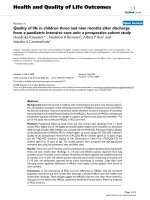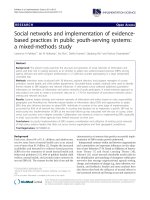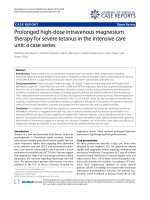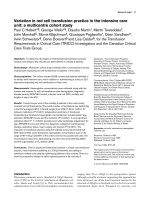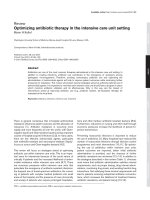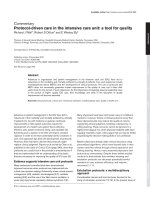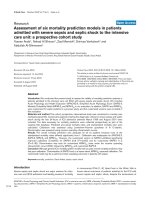Bóa cáo y học: " Empiric broad-spectrum antibiotic therapy of nosocomial pneumonia in the intensive care unit: a prospective observational study" docx
Bạn đang xem bản rút gọn của tài liệu. Xem và tải ngay bản đầy đủ của tài liệu tại đây (294.1 KB, 11 trang )
Open Access
Available online />Page 1 of 11
(page number not for citation purposes)
Vol 10 No 3
Research
Empiric broad-spectrum antibiotic therapy of nosocomial
pneumonia in the intensive care unit: a prospective observational
study
Francisco Álvarez-Lerma
1
, Bernabe Alvarez
2
, Pilar Luque
3
, Francisco Ruiz
4
, Jose-Maria Dominguez-
Roldan
5
, Elisabet Quintana
6
, Cesar Sanz-Rodriguez
7
and the ADANN Study Group
1
Servicio de Medicina Intensiva, Hospital del Mar, Barcelona, Spain
2
Servicio de Medicina Intensiva, Hospital General Universitario, Alicante, Spain
3
Servicio de Medicina Intensiva, Hospital Clínico Universitario, Zaragoza, Spain
4
Servicio de Medicina Intensiva, Complejo Hospitalario de Jaén, Spain
5
Servicio de Medicina Intensiva, Hospital Universitario Virgen del Rocío, Sevilla, Spain
6
Servicio de Medicina Intensiva, Hospital de la Santa Creu i Sant Pau, Barcelona, Spain
7
Department of Clinical Research, Merck Sharp & Dohme of Spain, Madrid, Spain
Corresponding author: Francisco Álvarez-Lerma,
Received: 10 Jan 2006 Revisions requested: 16 Feb 2006 Revisions received: 11 Apr 2006 Accepted: 18 Apr 2006 Published: 16 May 2006
Critical Care 2006, 10:R78 (doi:10.1186/cc4919)
This article is online at: />© 2006 Álvarez-Lerma et al.; licensee BioMed Central Ltd.
This is an open access article distributed under the terms of the Creative Commons Attribution License ( />),
which permits unrestricted use, distribution, and reproduction in any medium, provided the original work is properly cited.
Abstract
Introduction Antibiotic de-escalation, which consists of the
initial institution of empiric broad-spectrum antibiotics followed
by antibiotic streamlining driven by microbiological
documentation, is thought to provide maximum benefit for the
individual patient, while reducing the selection pressure for
resistance.
Methods To assess a carbapenem-based de-escalating
strategy in nosocomial pneumonia (NP), a prospective
observational study was conducted in critically ill patients with
NP treated empirically with imipenem ± aminoglycoside/
glycopeptide in 24 intensive care units of Spanish general
hospitals. Overall, 244 patients were assessable (91% with late-
onset NP). The primary outcome was therapeutic success 7–9
days post therapy.
Results Microbial identification – based on cultures of tracheal
aspirates in 82% of patients, cultures of protected specimen
brush in 33%, and cultures of bronchoalveolar lavage in 4% –
was only available for 131 (54%) patients. Initial antibiotics were
inadequate for 23 (9%) patients. Of the remaining patients,
antibiotics were streamlined in 56 (23%) patients and remained
unchanged in 14 (6%) patients based on microbiology data, in
38 (16%) patients despite microbiology data favouring de-
escalation, and in 113 (46%) patients due to unknown
aetiology. Overall, de-escalation was implemented in only 23%
of patients with potentially multiresistant pathogens, compared
with 68% of patients with the remaining pathogens (P < 0.001).
Response rates were 53% for patients continuously treated with
imipenem-based regimens and 50% for the de-escalated
patients. Higher Acute Physiology, Age, and Chronic Health
Evaluation II scores were associated with greater mortality,
whereas adequate empiric antibiotic therapy protected against
fatal outcomes. No increase of superinfection rates caused by
emerging pathogens was observed. The costs associated with
de-escalation were mainly dependent on the duration of
hospitalization.
Conclusion This study mainly highlights the current practice of
a specific algorithm of de-escalation solely based on the
available microbiological data, and highlights the barriers to
using it more widely. In this setting, de-escalation was less likely
to occur in the presence of potentially multiresistant pathogens.
Prior antibiotic administration and the low use of bronchoscopic
techniques may have influenced negatively the implementation
of de-escalation. Optimization of de-escalation strategies for NP
should rely on a correct choice of empiric antibiotics, on
appropriate microbiological investigations, and on a balanced
interpretation of microbiological and clinical data.
ADANN = Analysis of Antibiotic De-escalation for Nosocomial Pneumonia; BAL = bronchoalveolar lavage; ICU = intensive care unit; MITT = modified
intention-to-treat; MRSA = methicillin-resistant Staphylococcus aureus; NFGNB = nonfermenting Gram-negative bacilli; NP = nosocomial pneumo-
nia; PE = patient-evaluable; TA = Tracheal aspirate; VAP = ventilator-associated pneumonia.
Critical Care Vol 10 No 3 Álvarez-Lerma et al.
Page 2 of 11
(page number not for citation purposes)
Introduction
Inadequate antibiotic treatment is a major risk factor for noso-
comial pneumonia (NP)-attributed mortality [1-8] and is often
associated with antibiotic-resistant Gram-negative bacteria
and methicillin-resistant Staphylococcus aureus (MRSA)
[1,3,4,9]. Changes of antibiotics often follow the isolation of
microorganisms not covered by initial empiric antibiotics [4].
Yet the benefit of adequate antibiotic therapy may vanish if the
onset of effective treatment is delayed [2,3,10].
De-escalation, which consists of the initial institution in
severely ill patients of broad-spectrum antibiotics covering the
most probable causative pathogens followed by antibiotic
streamlining driven by microbiological documentation, is
thought to provide maximum benefit for the individual patient,
while reducing the selection pressure for resistance [11,12].
There are concerns, however, about the emergence of multid-
rug-resistant pathogens prompted by delayed streamlining of
unnecessary antibiotics and the potential negative influence
on diagnostic accuracy and economic impact of this strategy.
De-escalation was the main cause of antibiotic modification in
a series of patients with ventilator-associated pneumonia
(VAP) from one institution [13], being more feasible in early-
onset pneumonia and less frequent in the presence of nonfer-
menting Gram-negative bacilli (NFGNB) [13].
We designed a prospective multicentre observational study –
Analysis of Antibiotic De-escalation for Nosocomial Pneumo-
nia (ADANN) – to assess the clinical, microbiological, and
pharmacoeconomic features of a carbapenem-based de-
escalating strategy in intensive care unit (ICU) patients with
NP. Our hypothesis was that de-escalation was feasible, yet
highly dependent on the quality of microbiological investiga-
tions and the patient's clinical characteristics.
Materials and methods
Study design
This prospective, observational study was conducted in 24
ICUs of Spanish general hospitals in accordance with local
regulations. The protocol was approved by Hospital del Mar's
Ethical Committee.
Eligible patients aged ≥18 years had NP, were to receive
empirically imipenem-based antibiotic regimens, and were
required to have blood cultures and respiratory sampling per-
formed before starting the study therapy. Written informed
consent was obtained from the patients. Other diagnostic pro-
cedures were performed as needed.
Exclusion criteria included previous carbapenem administra-
tion during the ongoing NP episode; kidney dialysis, serum
creatinine >267 µmol/l or creatinine clearance <20 ml/minute;
development of pneumonia on days 1–4 post admission with-
out concomitant risk factors (prior antibiotics/steroids, insulin-
dependent diabetes mellitus, chronic obstructive pulmonary
disease, chronic atelectasis, cirrhosis, active cancer); carbap-
enem hypersensitivity; expected survival <48 hours; preg-
nancy/nursing; and human immunodeficiency virus infection.
Clinical management and study drug dosing regimen
The only therapeutic, diagnostic, or monitoring interventions
allowed were those considered standard clinical practice. Visit
1 corresponded to the onset of study therapy. On visit 2 (3–5
days later), investigators streamlined antibiotics if favourable
microbiological data were available. Patients were re-evalu-
ated after discontinuation of therapy (visit 3) and again 7–9
days later (visit 4).
Antibiotics were generally dosed as recommended in the cor-
responding package inserts. The most common dose of imi-
penem was 1 g/8 hours daily. Patients with suspected
Pseudomonas infection also received amikacin (15 mg/kg/
day) or tobramycin (5 mg/kg/day). If MRSA infection was sus-
pected, vancomycin (1 g/12 hours) or teicoplanin (400 mg/
12-hour load, 400 mg/day thereafter) were added.
Definitions
NP was defined per the Center for Disease Control and Pre-
vention clinical criteria [14]. The bacteriologic diagnosis
required one or more of the following criteria: tracheal aspirate
(TA) cultures yielding ≥10
5
colony-forming units/ml; protected
specimen brush cultures yielding ≥10
3
colony-forming units/
ml; bronchoalveolar lavage (BAL) cultures yielding ≥10
4
col-
ony-forming units/ml; blood or pleural fluid cultures yielding
the same pathogen as respiratory samples; histopathologic
evidence of pneumonia; or positive serology/identification of
Legionella pneumophila.
The proposed de-escalation approach encompassed two
stages. The first stage consisted of administering broad-spec-
trum empiric antibiotics (imipenem ± aminoglycoside and/or
glycopeptide). Empiric therapy was considered adequate if ≥1
antibiotic to which all isolates were susceptible was used after
the initial respiratory sampling. Carbapenem-resistant,
aminoglycoside-susceptible Pseudomonas infections were
always considered inadequately treated, even if they were
treated with imipenem in combination with an active aminogly-
coside. The second stage involved antibiotic streamlining
based on available microbiological data. The investigators
were provided with no rules and with no guidance for antibiotic
de-escalation. Streamlining was considered adequate if the
empiric regimen was changed to piperacillin/tazobactam, or to
an anti-pseudomonal cephalosporin if susceptible Pseu-
domonas aeruginosa was isolated, or to a non-antipseudomo-
nal β-lactam (witholding aminoglycosides and/or
glycopeptides if possible) if NFGNB were absent. Three inde-
pendent reviewers judged the adequacy of the empiric therapy
and the correctness of de-escalation.
Available online />Page 3 of 11
(page number not for citation purposes)
Clinical success required complete resolution of all attributa-
ble symptoms, signs, and radiographic and laboratory abnor-
malities. Failures included unsatisfactory clinical response, any
antibiotic addition or substitution, or death of any cause.
Deaths were attributed to NP if they occurred before any
objective response to antimicrobials or if NP contributed to
death in patients with comorbidities. The judgement of attrib-
utable mortality was made by the investigator who followed up
the patient at each study site.
Statistics
The primary outcome was therapeutic success 7–9 days post
study therapy, which was estimated at ~70% for sample size
calculations. Using a significance level of 0.05, a power of
94%, and 10% of patients lost to follow-up, 247 patients were
required for the 95% confidence interval of the response rate
to fall between 63% and 76%. Preplanned secondary objec-
tives included descriptive and comparative effectiveness, tox-
icity, mortality, superinfections, and cost analyses.
Effectiveness analyses were performed on modified intention-
to-treat (MITT) and patient-evaluable (PE) populations. The
MITT population only excluded patients misdiagnosed or dying
before treatment began. PE patients met MITT criteria, under-
went follow-up until visit 4 or death and had sufficient informa-
tion to determine outcomes, and received study therapy for ≥7
days for cured cases and for ≥3 days for failures.
Chi-square tests were used for effectiveness and mortality
contingency analyses. Forward stepwise logistic regression
analysis with a cutoff P value of 0.05 was used to determine
the relationship between outcome variables and independent
variables previously identified in univariate analyses (P <
0.05). For the costs, chi-square and Kruskal–Wallis tests were
Figure 1
Study overview: flow chart representing the patient flow throughout the different study visitsStudy overview: flow chart representing the patient flow throughout the different study visits. Visit 1, onset of study therapy; visit 2 (3–5 days later),
investigators streamlined antibiotics if favourable microbiological data were available; visit 3, patients were re-evaluated after discontinuation of ther-
apy, visit 4, patients were re-evaluated 7–9 days later. MITT, modified intention-to-treat; D, dead; LFU, lost to follow-up.
Critical Care Vol 10 No 3 Álvarez-Lerma et al.
Page 4 of 11
(page number not for citation purposes)
used for categorical variables and continuous variables,
respectively.
Results
Two hundred and fifty-eight patients with a first episode of NP
were enrolled from April 2000 to June 2001. Fourteen patients
did not meet the MITT criteria and 31 patients were lost to fol-
low-up (Figure 1). No selection bias was identified in a com-
Table 1
Baseline characteristics of modified intention-to-treat patients grouped as defined per bacteriologic documentation (visit 2)
Group I (n = 113,
46.3%)
Group II (n = 14,
5.7%)
Group III (n = 38,
15.6%)
Group IV (n = 56,
23.0%)
Group V (n = 23,
9.4%)
Overall (n = 244,
100%)
Gender (%)
Male 75.2 78.6 68.4 78.6 73.9 75.0
Female 24.8 21.4 31.6 21.4 26.1 25.0
Age (years)
Mean (standard deviation) 54.8 (16.6) 54.9 (22.9) 55.5 (20.1) 52.8 (18.7) 51.3 (22.4) 54.1 (18.5)
Diagnosis of nosocomial pneumonia (%)
Early onset 8.0 - 7.9 14.3 13.0 9.4
Late onset 92.0 100 92.1 85.7 87.0 90.6
Prior therapy (%)
Antibiotics 86.7 85.7 76.3 64.3 78.3 79.1
Steroids 19.5 21.4 26.3 21.4 21.7 21.3
Vital signs (%)
Fever (>38.2°C) 50.4 42.9 71.1 55.4 39.1 53.3
Tachypnea (>20 cycles/minute) 36.6 35.7 34.2 39.3 40.9 37.2
Systolic hypotension (<100 mmHg) 37.2 57.1 47.4 33.9 43.5 39.8
Tachycardia (>110 beats/minute) 30.4 35.7 23.7 28.6 30.4 29.2
Pulmonary function (%)
PaO
2
/FiO
2
< 250 mmHg
a
85.2 81.8 89.3 83.0 50.0 81.5
Other therapies (%)
Mechanical ventilation
b
76.1 85.7 92.1 87.3 95.5 83.5
Vasoactive drugs 45.5 50.0 45.9 33.9 54.5 44.0
APACHE II score
Mean (standard deviation) 17.4 (7.0) 17.6 (9.0) 17.3 (8.3) 16.0 (6.0) 18.3 (7.8) 17.2 (7.2)
0–8 (%) 8.0 14.3 15.8 8.9 4.3 9.4
9–16 (%) 42.5 28.6 31.6 42.9 34.8 39.3
17–24 (%) 33.6 28.6 39.5 42.9 43.5 37.3
>24 (%) 15.9 28.6 13.2 5.4 17.4 13.9
Concomitant diseases (%)
Any 67.3 64.3 47.4 58.9 60.9 61.5
Cardiovascular disease 25.7 42.9 21.1 21.4 30.4 25.4
Chronic respiratory disease 25.7 21.4 10.5 17.9 21.7 20.9
Liver disease 8.0 7.1 5.3 7.1 - 6.6
Renal dysfunction 5.3 7.1 2.6 3.6 - 4.1
Active neoplasia 4.4 14.3 2.6 8.9 17.4 7.0
Group I, patients with an unknown aetiology and unmodified therapy; Group II, patients with resistant organisms, who had unmodified therapy;
Group III, patients with susceptible organisms, who had unmodified therapy; Group IV, patients who had susceptible organisms and whose therapy
was modified accordingly; and Group V, patients who initially received inadequate antibiotic therapy, which was later modified on the basis of
cultures. APACHE, Acute Physiology, Age, and Chronic Health Evaluation.
a
Chi-square test, P < 0.01.
b
Chi-square test, P = 0.052.
Available online />Page 5 of 11
(page number not for citation purposes)
parative analysis of the baseline characteristics of patients lost
to follow-up. Overall, there were 244 MITT patients and 213
PE patients (170 alive on visit 4, 43 dead between visits 2 and
4) (Figure 1). Tables 1 and 2 display patient demographics
and the empiric antibiotic therapy, respectively.
Favourable response rates among MITT patients were 75.4%
upon completion of therapy and were 50.4% 7–9 days later,
with no significant differences across treatment groups (Table
3). The PE analysis was supportive of the primary MITT analy-
sis. Increasing baseline Acute Physiology, Age, and Chronic
Health Evaluation II scores were associated with a lower likeli-
hood of favourable response (P < 0.01). The mortality analysis
was performed only in PE patients. Overall, 20.2% PE patients
died. The NP-attributed mortality was 13.6%, which repre-
sented 67.4% of all deaths.
Microbiological identification was based on TA cultures per-
formed in 199 (81.6%) patients, protected specimen brush
cultures performed in 80 (32.8%) patients, and BAL cultures
performed in only 10 (4.1%) patients. On visit 2, bacteriologic
documentation was only available for 131 (53.7%) patients
(Table 4). NFGNB (mainly Pseudomonas and Acinetobacter),
Enterobacteriaceae, and S. aureus represented 38.4%,
20.5%, and 17.8% of all pathogens causing monomicrobial
infections, respectively. NFGNB and S. aureus were also com-
mon in polymicrobial infections and occurred more frequently
in patients previously treated with antibiotics (P = 0.02 for
monomicrobial infections, P < 0.001 for polymicrobial infec-
tions). On visit 2, patients were grouped based on the availa-
bility of microbiological data and therapeutic decisions as
follows: Group I included 113 (46.3%) patients with an
unknown aetiology and unmodified therapy; Group II included
14 (5.7%) patients with resistant organisms, who had unmodi-
fied therapy; Group III included 38 (15.6%) patients with sus-
ceptible organisms, who had unmodified therapy; Group IV
included 56 (23.0%) patients who had susceptible organisms
and whose therapy was modified accordingly; and Group V
included 23 (9.4%) patients who initially received inadequate
antibiotic therapy, which was later modified on the basis of
cultures.
For patients included in the latter group, bacteriologic investi-
gations yielded carbapenem-resistant Acinetobacter spp.
(seven patients); P. aeruginosa (three patients) and Pseu-
domonas putida (one patient); Escherichia coli (one patient),
Proteus mirabilis (one patient), and Serratia marcescens (one
patient) with full or intermediate imipenem resistance; MRSA
(seven patients, none received empiric glycopeptides); Myco-
bacterium tuberculosis (two patients); and Candida albicans
(one blood culture isolate). Both the overall mortality and the
NP-attributed mortality were higher in inadequately treated
patients despite modification of initial antibiotics within 72
hours. A logistic regression analysis confirmed the association
between inadequate therapy and overall mortality (Table 3).
Susceptible strains were identified in 108 (44.3%) patients,
yet antibiotics were only streamlined in 56 patients (Group IV).
Table 2
Initial empiric antibiotic therapy in modified intention-to-treat patients grouped as defined per bacteriologic documentation (visit 2)
Group I (n =
113, 46.3%)
Group II (n =
14, 5.7%)
Group III (n =
38, 15.6%)
Group IV (n
= 56, 23.0%)
Group V (n =
23, 9.4%)
Overall (n =
244, 100%)
Chi-square P
value
Dose of imipenem (%) 0.51
<3 g/day 19.5 - 10.5 9.0 17.3 14.3
3 g/day 62.885.773.760.765.265.6
>3 g/day 17.714.315.830.417.420.1
Empiric regimen (%) 0.64
Imipenem only 19.5 7.1 18.4 21.4 8.7 18.0
Imipenem + aminoglycoside37.250.042.248.234.841.0
Amikacin 24.828.621.141.126.128.3
Tobramycin 12.421.421.17.1 8.7 12.7
Imipenem + glycopeptide 15.0 21.4 21.1 8.9 21.7 15.6
Vancomycin 9.7 21.4 13.2 8.9 13.0 11.1
Teicoplanin 5.3 - 7.9 - 8.7 4.5
Imipenem + aminoglycoside
+ glycopeptide
28.321.418.421.434.825.4
Group I, patients with an unknown aetiology and unmodified therapy; Group II, patients with resistant organisms, who had unmodified therapy;
Group III, patients with susceptible organisms, who had unmodified therapy; Group IV, patients who had susceptible organisms and whose
therapy was modified accordingly; and, Group V, patients who initially received inadequate antibiotic therapy, which was later modified on the
basis of cultures.
Critical Care Vol 10 No 3 Álvarez-Lerma et al.
Page 6 of 11
(page number not for citation purposes)
The overall de-escalation rate was therefore 23.0% (56/244
patients). This proportion increased to 25.3% (56/221
patients) when inadequate treatments were excluded, to
42.7% (56/131 patients) when episodes of unknown aetiol-
ogy were excluded, and to 51.9% (56/108 patients) when epi-
sodes with susceptible strains only were considered. Empiric
antibiotics remained unchanged in 52 (21.3%) patients with
documented aetiology.
Fourteen patients did not have narrower spectrum alternatives
(Group II). Pathogens in this treatment group included Aci-
netobacter spp. (11 cases), P. aeruginosa (two cases), Kleb-
siella pneumoniae (one case), and Enterobacter aerogenes
(one case). Empiric antibiotics were not streamlined despite
favourable microbiological data in the remaining 38 patients
(Group III). Overall, antibiotics were streamlined in only nine of
39 patients (23.1%) with potentially multiresistant pathogens
(for example, NFGNB and MRSA), compared with 47 of 69
patients (68.1%) among the remaining pathogens (P <
0.001). Of the 30 patients with potentially multiresistant path-
ogens who were not de-escalated, 14 belonged in Group II
and 16 in Group III. Finally, the initial empiric regimen was also
maintained in 113 (46.3%) patients with unknown aetiology
(Group I).
The duration of antibiotic therapy was similar in patients who
were de-escalated (median, 18 days; range, 4–55 days) ver-
sus that in patients who were not de-escalated (median, 16
days; range, 3–65 days; P > 0.05), yet was longer than for
patients with unknown aetiology (median, 13 days; range, 4–
72 days; P = 0.02). Not surprisingly, imipenem was less used
in the former (median, 5 days versus 14 days versus 11 days;
P < 0.001). Superinfections were diagnosed in 16 (6.6%)
patients, most of whom had prior antibiotic exposure. Bacteri-
ologic testing of TA (12 patients), protected specimen brush
(one patient), and BAL (one patient) yielded P. aeruginosa (six
Table 3
Effectiveness and mortality analyses for each treatment group as defined per bacteriologic documentation (visit 2)
Group I Group II Group III Group IV Group V Overall
Effectiveness response rates
Modified intention-to-treat population (n = 113) (n = 14) (n = 38) (n = 56) (n = 23) (n = 244)
End of therapy (visit 3) (%) 81.4 78.6 68.4 75.0 56.5 75.4
Final evaluation (visit 4) (%) 54.0 64.3 44.7 50.0 34.8 50.4
Patient-evaluable population (n = 100) (n = 11) (n = 36) (n = 48) (n = 18) (n = 213)
Final evaluation (visit 4) (%) 61.0 81.8 47.2 58.3 44.4 57.7
Mortality rates
Patient-evaluable population (n = 100) (n = 11) (n = 36) (n = 48) (n = 18) (n = 213)
Overall mortality (%) 19.0 18.2 25.0 14.6 33.3 20.2
Nosocomial pneumonia-attributable
mortality (%)
15.0 9.1 8.3 8.3 33.3 13.6
Variables independently associated with
overall mortality by logistic regression
analysis
Adjusted odds ratio 95% confidence interval P
Age (year of age) 1.019 1.001–1.038 0.033
Baseline APACHE II score (per point) 1.064 1.019–1.111 0.004
Treatment group (referred to Group V) 0.014
Group I 0.341 0.118–0.859
Group II 0.116 0.020–0.691
Group III 0.341 0.108–1.080
Group IV 0.138 0.042–0.454
Constant 0.151 0.038–0.607 -
Forward stepwise logistic regression analysis (cut-off P value of 0.05) was used to determine the relationship between mortality and independent
baseline variables previously identified in univariate analyses (P < 0.05), including: age, mechanical ventilation, Acute Physiology, Age, and
Chronic Health Evaluation (APACHE) II score, treatment group, and adequacy of initial empiric therapy. Group I, patients with an unknown
aetiology and unmodified therapy; Group II, patients with resistant organisms, who had unmodified therapy; Group III, patients with susceptible
organisms, who had unmodified therapy; Group IV, patients who had susceptible organisms and whose therapy was modified accordingly; and
Group V, patients who initially received inadequate antibiotic therapy, which was later modified on the basis of cultures.
Available online />Page 7 of 11
(page number not for citation purposes)
Table 4
Microbiologic documentation available in visit 2 in modified intention-to-treat patients with nosocomial pneumonia
Prior antibiotic therapyOverallPercentage
performed
Chi-square P value
No Yes
Pathogens (%) 0.002
None 27.5 51.8 52.5
Monomicrobial 33.3 29.0 29.9
Polymicrobial 39.2 19.2 23.8
Yield of microbial investigations (%)
Tracheal aspirate 87.5 79.5 81.4 81.6
Protected specimen brush 96.3 67.9 80.0 32.8
Bronchoalveolar lavage 100 71.4 77.5 4.1
Pathogens identified (all patients)
Monomicrobial 17 56 73 0.02
Pseudomonas aeruginosa 11314
Other Pseudomonas 022
Acinetobacter baumannii 01111
Other Acinetobacter 011
Enterobacteriaceae 31215
Staphylococcus aureus 4913
Haemophylus influenzae 6511
Streptococcus pneumoniae 224
Streptococcus viridans group 000
Other 1 1 2
Polymicrobial 20 38 58 <0.001
Mixed, including NFGNB and methicillin-resistant
S. aureus
42327
H. influenzae plus Streptococcus spp.9211
Other 7 13 20
Pathogens identified (Group V
a
)
Monomicrobial 1 7 8
P. aeruginosa 123
Other NFGNB 0 2 2
Enterobacteriaceae 011
Methicillin-resistant S. aureus 011
Other 0 1 1
Polymicrobial 4 11 15
Mixed, including NFGNB and methicillin-resistant
S. aureus
189
Other 3 3 6
NFGNB, nonfermenting Gram-negative bacilli. Overall, there were 33 Pseudomonas isolates, including 30 Pseudomonas aeruginosa, two
Pseudomonas putida, and one Pseudomonas spp., and 22 Acinetobacter isolates, including 20 A. baumannii, one Acinetobacter haemolyticus,
and one Acinetobacter calcoaceticus.
a
Group V, patients who initially received inadequate antibiotic therapy, which was later modified on the basis
of cultures.
Critical Care Vol 10 No 3 Álvarez-Lerma et al.
Page 8 of 11
(page number not for citation purposes)
cases), Acinetobacter baumannii (four cases), MRSA (three
cases), methicillin-susceptible S. aureus (one case), Kleb-
siella oxytoca (one case), and Enterobacter cloacae (one
case). Two additional patients had positive blood cultures to
C. albicans and Enterococcus faecalis, respectively. Interest-
ingly, superinfection rates were similar across treatment
groups (Group I, 7.1%; Group II, 7.1%; Group III, 2.6%;
Group IV, 5.4%; Group V, 13.0%) regardless of the different
duration of broad-spectrum therapy.
Antibiotic-related adverse reactions included seizures (three
episodes probably or possibly related to imipenem), thrombo-
cytosis (one episode probably related to cefotaxime), rash
(one episode probably related to vancomycin), acute tubular
necrosis (one episode possibly related to amikacin), and ele-
vated serum aminotransferase levels (one episode possibly
related to imipenem). Adverse reactions were generally mild to
moderate, only causing therapy discontinuation in three
patients (two seizures, one rash).
A cost analysis focusing on the duration and costs of hospital-
ization was conducted from Spanish National Health Insur-
ance perspective (Table 5). The duration and costs of the ICU
stay were higher for patients with microbiological diagnosis
who were not de-escalated (P < 0.001 and P = 0.001,
respectively), while the costs of diagnostics and drugs other
than antibiotics were higher for inadequately treated patients
and for patients not de-escalated despite favourable microbi-
ology (P = 0.04). Although this resulted in significant differ-
ences in total cost per NP episode (P = 0.01), there were no
differences in the total daily costs between treatment groups,
which averaged €326.07 (P = 0.35).
Discussion
In this study, initial empiric antibiotics were streamlined in
51.9% episodes with susceptible microbial isolates in patients
who were given appropriate initial therapy. This proportion fell
to 42.7% when episodes of unknown aetiology were
excluded, to 25.3% when inadequately treated patients were
excluded, and to 23.0% when all 244 evaluable patients were
considered. These figures are in general agreement with an
earlier report [13], where de-escalation was possible in 38%
of VAP episodes with susceptible pathogens (34.2% and
31% when resistant strains and unknown aetiology were
included, respectively). These data are, however, much higher
than the 6.1% found in a previous cohort of patients with VAP
[1]. The low de-escalation rate in this latter experience was
probably due to the high prevalence of Pseudomonas
(48.3%), much greater than that found in our study (30.6%
(33/108 patients)) and than that recently reported by Rello
and colleagues (17.4%) [13]. The impact of local susceptibil-
ity patterns on the de-escalation strategy is further evidenced
by our observation that patients with potentially multiresistant
pathogens (NFGNB and MRSA) were de-escalated less fre-
quently than patients with other pathogens (23.1% versus
68.1%; P ≤ 0.001).
Table 5
Cost analysis in modified intention-to-treat patients grouped as defined per bacteriologic documentation (visit 2)
Group I (n = 113,
46.3%)
Group II (n = 14,
5.7%)
Group III (n = 38,
15.6%)
Group IV (n = 56,
23.0%)
Group V (n = 23,
9.4%)
Overall (n = 244,
100%)
Kruskal–Wallis P
value
Hospital
admission (days)
23.8 (39.9) 19.9 (19.9) 22.1 (36.0) 14.9 (19.0) 33.8 (81.2) 22.3 (40.9) 0.46
ICU admission
(days)
20.5 (34.1) 34.0 (32.2) 36.7 (24.2) 23.7 (14.5) 17.8 (79.0) 24.3 (36.4) <0.001
Costs of
hospitalization in the
general ward (€)
4,983.40
(8,754.20)
4,160.47
(4,461.11)
4,835.13
(8,023.24)
2,983.81
(4,164.14)
7,264.92
(8.754.20)
4,669.23
(8,971.35)
0.44
Costs of ICU
admission (€)
6,725.70
(11,412.94)
11,469.22
(10,872.13)
12,055.11
(8,283.93)
7,860.99
(4,965.19)
5,749.28
(26,069.12)
7,996.38
(12,182.74)
0.001
Antibiotic
acquisition costs
(€)
539.98
(2,636.00)
533.03 (622.62) 487.49
(1,002.59)
322.06 (300.38) 360.09 (446.92) 464.44
(1,850.30)
0.97
Other therapeutic
and diagnostic
procedures (€)
631.26 (462.19) 591.61 (278.65) 853.59 (531.50) 652.41 (399.60) 855.75 (513.94) 689.63 (463.63) 0.04
Total costs per
episode (€)
12,880.35
(9,420.68)
16,754.33
(10,977.94)
18,231.32
(13,402.92)
11,819.28
(7,007.02)
14,230.04
(10,571.25)
13,819.67
(10,041.06)
0.01
Total daily costs
(€)
324.05 (102.29) 327.16 (41.17) 337.95 (46.27) 332.19 (39.40) 301.22 (156.78) 326.07 (89.22) 0.35
Data presented as mean (standard deviation). ICU, intensive care unit. Costs were estimated using drug label information and data published by
Institut Municipal d'Assistència Sanitària and Laboratori de Referència de Catalunya (Barcelona, Spain) updated through 2001. Group I, patients
with an unknown aetiology and unmodified therapy; Group II, patients with resistant organisms, who had unmodified therapy; Group III, patients with
susceptible organisms, who had unmodified therapy; Group IV, patients who had susceptible organisms and whose therapy was modified
accordingly; and Group V, patients who initially received inadequate antibiotic therapy, which was later modified on the basis of cultures.
Available online />Page 9 of 11
(page number not for citation purposes)
The feasibility of de-escalation may also depend on the
patients' clinical characteristics. The lower de-escalation rate
in our study compared with that previously reported in VAP
patients [13] could be partly due to the intensive prior use of
antibiotics (79.1%) in our series and the larger proportion of
late-onset episodes in our study (90.6% versus 62.8%). Also,
in our study de-escalation was not implemented in 15.6% of
all patients with known aetiology. Similarly, Rello and col-
leagues [13] reported that empirical therapy remained
unchanged in 10% of VAP patients due to delayed clinical
resolution.
De-escalation was not carried out in 113 patients with nega-
tive cultures, which resulted in a prolonged administration of
imipenem (median, 11 days). In our view, a wider use of the
bronchoscopic techniques, with higher specificity than TA cul-
tures, may have facilitated the proposed de-escalation strat-
egy in our study. Although we believe the high proportion of
patients with negative cultures who were not de-escalated
was probably influenced by the lack of specific recommenda-
tions for de-escalation in this patient group, whether or not de-
escalation was still possible remains an issue to be defined. In
Rello and colleagues' study [13], patients with unknown aeti-
ology were re-evaluated 2–3 days after the onset of therapy;
those clinically improved continued to receive short-course
antibiotics, while nonresponders were switched to different
antibiotics. The authors concluded that de-escalation was not
possible in patients with negative cultures since antibiotics
were only changed in 30% of the episodes due to clinical
deterioration. The results of a more recent prospective study,
however, suggest that patients with a clinical suspicion of VAP
and culture-negative BAL can have empiric antimicrobial ther-
apy safely discontinued within 72 hours or in some cases with-
held altogether [15].
De-escalation is expected to minimize inappropriate initial anti-
biotic therapies, which result in higher mortality [1-8]. In our
study, inadequate initial empiric therapy occurred in 9.4% of
MITT patients and was associated with increased mortality
(Table 3). This rate was similar to that recently reported in VAP
patients [13]. Pathogens identified in this patient group
included carbapenem-resistant Acinetobacter spp., MRSA
(only in patients not given empiric glycopeptides), M. tubercu-
losis, and C. albicans. The question remains of how many of
these patients could have benefited from an appropriate
empiric antibiotic regimen, had they been previously identified
as being at high risk for antibacterial-resistant infections.
While it has been shown that extensive carbapenem use may
lead to increases in resistance [16,17], in some studies imi-
penem-based empiric strategies did not lead to higher rates of
bacterial and fungal superinfections [18,19]. Yet, it is generally
agreed that in order to avoid unnecessary selection pressure
on microorganisms resulting from the use of broad-spectrum
antibiotics [20-23], carbapenems should always be used for
empiric therapy based on local epidemiology. In order to con-
trol potential confusing factors related to the different trends
of antibiotic use across participating institutions, the study
design only allowed the enrolment of patients empirically
treated with imipenem-based regimens, which are common in
Spanish institutions based on the local pathogens and antibi-
otic susceptibilities [24,25]. Interestingly, the incidence of
superinfections was low despite the large proportion of
patients (67.6%) continuously treated with imipenem until clin-
ical resolution. Nonetheless, no general conclusion can be
drawn regarding the impact of a carbapenem-based de-esca-
lation strategy on the emergence of resistant pathogens
based on this study, since the proportion of NP episodes
empirically treated with imipenem varied significantly between
institutions.
The cost analysis suggested that resource use associated
with de-escalation for NP was mainly dependent on the costs
of diagnostic and therapeutic procedures other than antibiot-
ics and, probably, the duration of hospitalization (probably
driven by the severity of disease), but not heavily influenced by
antibiotics acquisition costs. These data challenge the
assumption that the widespread use of broad-spectrum antibi-
otics in patients lacking a definite microbiologic diagnosis may
escalate costs.
This observational study has several limitations; most notably,
the lack of a control group and pre-established de-escalation
recommendations, and the study focus being on patients
empirically treated with imipenem-based regimens only. The
study design was therefore not appropriate to draw any con-
clusions regarding the benefits of carbapenem-based de-
escalation strategies. Another major limitation was the large
proportion of patients lacking microbiological documentation
in the absence of guidance on the duration of empiric antibi-
otic therapy. Changes of therapy in this patient group were
most probably prompted by nonresponse to empiric antibiot-
ics. Finally, there were no standardized criteria for admission,
diagnosis, and the initial choice of empiric antibiotics across
participating ICUs. The relatively low cure rates observed
could be partly due to suboptimal dosing of the different anti-
biotics used for empiric therapy resulting from the wide phar-
macokinetic variations typically occurring in critically ill
patients. Further studies are needed to evaluate the magnitude
of changes in antibiotic use and clinical outcomes resulting
from the implementation of de-escalation strategies.
Conclusion
The findings herein reported were based on a diagnostic strat-
egy mainly supported by TA cultures obtained before the initi-
ation of empiric imipenem-based therapy in a cohort of
patients with 90% of late-onset NP episodes. De-escalation
was implemented in 51.9% of episodes with susceptible
microbial isolates but was not performed if the pathogen
remained unknown. The intensive prior use of antibiotics and
Critical Care Vol 10 No 3 Álvarez-Lerma et al.
Page 10 of 11
(page number not for citation purposes)
the infrequent use of invasive bronchoscopic techniques may
have contributed to the large number of episodes with
unknown aetiology. De-escalation was more likely to occur in
the presence of potentially multiresistant pathogens, mainly
NFGNB.
The results of this study suggest that optimization of de-esca-
lation strategies for the treatment of critically ill patients with
NP should rely on the following principles. First, the choice of
empiric antibiotics should be based both on local pathogen
prevalence and antibacterial susceptibility and on the identifi-
cation of patients with selected clinical parameters at high risk
of developing infections caused by multi-resistant microorgan-
isms. Good-quality culture sampling is also needed before
starting antibacterial therapy. Finally, specific recommenda-
tions need be developed for patients with unknown aetiology
in order to reduce the duration of empiric therapy.
Competing interests
This observational study was sponsored by Merck Sharp &
Dohme of Spain. CS-R is an employee of Merck Sharp &
Dohme of Spain and holds stock options in the Company. FA-
L, BA, PL, FR, J-MD-R, and EQ have no financial or non-finan-
cial competing interests to be disclosed.
Authors' contributions
FA-L made substantial contributions to the conception and
design of the study, served as the Clinical Monitor for the
study, participated in the analysis and interpretation of the
data, and was involved in the drafting of the manuscript. CS-R
contributed to the analysis and interpretation of data, and was
involved in the drafting of the manuscript. BA, PL, FR, J-MD-R,
and EQ were involved in revising the manuscript critically. All
authors read and approved the final manuscript.
Acknowledgements
This observational study was sponsored and funded by Merck Sharp &
Dohme of Spain. Monitoring, including 100% source data verification,
was performed by Chiltern International Spain. Data acquisition and
entry into the study database, and analysis and interpretation of data
were carried out by Health Outcomes Research Europe.
The following investigators and centres participated in the ADANN
Study: Dr Bernabe Alvarez, Hospital General Universitario, Alicante; Dr
Jordi Rello, Dr Yolanda del Castillo, and Dr Alejandro Rodriguez, Hospi-
tal Universitari Joan XXIII, Tarragona; Dr Francisco Álvarez-Lerma, Hos-
pital del Mar, Barcelona; Dr Pilar Luque, Hospital Clinico Lozano Blesa,
Zaragoza; Dr Francisco Ruiz, Complejo Hospitalario de Jaen, Jaen; Dr
Jose M. Dominguez, Hospital Virgen del Rocio, Sevilla; Dr Elisabet Quin-
tana, Hospital de la Santa Creu i Sant Pau, Barcelona; Dr Miguel
Benítez, Hospital Infanta Cristina, Badajoz; Dr Jose Ferreras, Hospital
Clínico Universitario, Valencia; Dr Angel Garnacho, Hospital Universitari
Vall d'Hebron, Barcelona; Dr Manuel Jimenez, Hospital Universitario La
Paz, Madrid; Dr Ricard Jorda, Hospital Son Dureta, Palma de Mallorca;
Dr Pablo Ucio, Hospital Clínico Universitario, Valladolid; Dr Carlos Fern-
andez, Hospital Universitario de León, León; Dr Pedro Olaechea, Hos-
pital de Galdákano, Galdákano; Dr Luis Alvarez-Rocha, Hospital Juan
Canalejo, La Coruña; Dr Rafael Sierra, Hospital Puerta del Mar, Cádiz;
Dr Armando Blanco, Hospital Central de Asturias, Oviedo; Dr Andres
Ruiz-Valverde and Dr Juan-Francisco Martinez-Coronel, Hospital Torre-
cardenas, Almería; Dr Javier Blanco, Hospital Xeral-Calde, Lugo; Dr
Javier López, Hospital Ramon y Cajal, Madrid; Dr Pilar Marco and Dr
Angel Mendieta, Hospital Donostia, San Sebastian; Dr Pablo Ugarte,
Hospital Marques de Valdecilla, Santander; and Dr Marcio Borges Sa,
Hospital 12 de Octubre, Madrid.
References
1. Rello J, Gallego M, Mariscal D, Sonora R, Valles J: The value of
routine microbial investigation in ventilator-associated
pneumonia. Am J Respir Crit Care Med 1997, 156:196-200.
2. Iregui M, Ward S, Sherman G, Fraser VJ, Kollef MH: Clinical
importance of delays in the initiation of appropriate antibiotic
treatment for ventilator-associated pneumonia. Chest 2002,
122:262-268.
3. Luna CM, Vujacich P, Niederman MS, Vay C, Gherardi C, Matera
J, Jolly EC: Impact of BAL data on the therapy and outcome of
ventilator-associated pneumonia. Chest 1997, 111:676-685.
4. Álvarez-Lerma F: Modification of empiric treatment in patients
with pneumonia acquired in the intensive care unit. ICU-
Acquired Pneumonia Study Group. Intensive Care Med 1996,
22:387-394.
5. Kollef MH, Sherman G, Ward S, Fraser VJ: Inadequate antimicro-
bial treatment of infections: a risk factor for hospital mortality
among critically ill patients. Chest 1999, 115:462-474.
6. Kollef MH: Inadequate antimicrobial treatment: an important
determinant of outcome for hospitalized patients. Clin Infect
Dis 2000, 31:S131-S138.
7. Celis R, Torres A, Gatell JM, Almela M, Rodriguez-Roisin R, Agusti-
Vidal A: Nosocomial pneumonia: a multivariate analysis of risk
and prognosis. Chest 1988, 93:318-324.
8. Torres A, Aznar R, Gatell JM, Jimenez P, Gonzalez J, Ferrer A, Celis
R, Rodriguez-Roisin R: Incidence, risk, and prognosis factors of
nosocomial pneumonia in mechanically ventilated patients.
Am Rev Respir Dis 1990, 142:523-528.
9. Kollef MH, Ward S: The influence of mini-BAL cultures on
patient outcomes: implications for the antibiotic management
of ventilator-associated pneumonia. Chest 1998,
113:412-420.
Key messages
• Inadequate empirical antibiotic therapy contributes sub-
stantially to attributed mortality in critically ill patients
with NP. Appropriate antibiotic therapy for NP contin-
ues to be a major challenge in the ICU setting.
• The antibiotic de-escalation strategy has recently been
introduced to increase coverage against the most fre-
quently causative pathogens, including multiresistant
strains, and to reduce the selection pressure for antimi-
crobial resistance.
• In a prospective observational multicentre study, the
causative organism was only identified in 54% of
patients with NP. De-escalation was used in 23% of
cases. In 16% of cases, despite microbiology data
favouring de-escalation, it was not applied. Empirical
antibiotic treatment was inadequate in 9% of patients.
• Response rates were 53% for patients continuously
treated with imipenem-based regimens versus 50% for
those patients who were de-escalated. Patients with
inappropriate empirical treatment had significantly
higher mortality.
Available online />Page 11 of 11
(page number not for citation purposes)
10. Mathevon T, Souweine B, Traore O, Aublet B, Caillaud D: ICU-
acquired nosocomial infection: impact of delay of adequate
antibiotic treatment. Scand J Infect Dis 2002, 34:831-835.
11. Kollef MH: Appropriate empirical antibacterial therapy for
nosocomial infections: getting it right the first time. Drugs
2003, 63:2157-2168.
12. Hoffken G, Niederman MS: Nosocomial pneumonia: the impor-
tance of a de-escalation strategy for antibiotic treatment of
pneumonia in the ICU. Chest 2002, 122:2183-2196.
13. Rello J, Vidaur L, Sandiumenge A, Rodriguez A, Gualis B, Boque
C, Diaz E: De-escalation therapy in ventilator-associated
pneumonia. Crit Care Med 2004, 32:2183-2190.
14. Garner JS, Jarvis WR, Emori TG, Horan TC, Hughes JM: CDC def-
initions of nosocomial infections. Am J Infect Control 1988,
16:128-140.
15. Kollef MH, Kollef KE: Antibiotic utilization and outcomes for
patients with clinically suspected ventilator-associated pneu-
monia and negative quantitative BAL culture results. Chest
2005, 128:2706-2713.
16. Carmeli Y, Troillet N, Eliopoulos GM, Samore MH: Emergence of
antibiotic-resistant Pseudomonas aeruginosa: comparison of
risks associated with different antipseudomonal agents. Anti-
microb Agents Chemother 1999, 43:1379-1382.
17. Lepper PM, Grusa E, Reichl H, Hogel J, Trautmann M: Consump-
tion of imipenem correlates with beta-lactam resistance in
Pseudomonas aeruginosa. Antimicrob Agents Chemother
2002, 46:2920-2925.
18. Aoun M, Crokaert F, Paesmans M, Autier P, Klastersky J: Imi-
penem versus targeted therapy in cancer patients. Int J Anti-
microb Agents 1998, 10:263-270.
19. Namias N, Harvill S, Ball S, McKenney MG, Salomone JP, Sleeman
D, Civetta JM: Empiric therapy of sepsis in the surgical inten-
sive care unit with broad-spectrum antibiotics for 72 hours
does not lead to the emergence of resistant bacteria. J Trauma
1998, 45:887-891.
20. McGowan JE Jr: Antimicrobial resistance in hospital organisms
and its relation to antibiotic use. Rev Infect Dis 1983,
5:1033-1048.
21. Rahal JJ, Urban C, Horn D, Freeman K, Segal-Maurer S, Maurer J,
Mariano N, Marks S, Burns JM, Dominick N, et al.: Class restric-
tion of cephalosporin use to control total cephalosporin resist-
ance in nosocomial Klebsiella. JAMA 1998, 280:1233-1237.
22. Fridkin SK, Edwards JR, Tenover FC, Gaynes RP, McGowan JE Jr:
Intensive Care Antimicrobial Resistance Epidemiology
(ICARE) Project. National Nosocomial Infections Surveillance
(NNIS) System Hospitals. Antimicrobial resistance prevalence
rates in hospital antibiograms reflect prevalence rates among
pathogens associated with hospital-acquired infections. Clin
Infect Dis 2001, 33:324-330.
23. Fridkin SK, Edwards JR, Courval JM, Hill H, Tenover FC, Lawton R,
Gaynes RP, McGowan JE Jr: Intensive Care Antimicrobial
Resistance Epidemiology (ICARE) Project. National Nosoco-
mial Infections Surveillance (NNIS) System Hospitals. The
effect of vancomycin and third-generation cephalosporins on
prevalence of vancomycin-resistant enterococci in 126 U.S.
adult intensive care units. Ann Intern Med 2001, 135:173-183.
24. Rello J, Sa-Borges M, Correa H, Leal SR, Baraibar J: Variations in
etiology of ventilator-associated pneumonia across four treat-
ment sites: implications for antimicrobial prescribing
practices. Am J Respir Crit Care Med 1999, 160:608-613.
25. Álvarez-Lerma F, Insausti-Ordenana J, Jorda-Marcos R, Maravi-
Poma E, Torres-Marti A, Nava J, Martinez-Pellus A, Palomar M, Bar-
cenilla F: Efficacy and tolerability of piperacillin/tazobactam
versus ceftazidime in association with amikacin for treating
nosocomial pneumonia in intensive care patients: a prospec-
tive randomized multicenter trial. Intensive Care Med 2001,
27:493-502.
